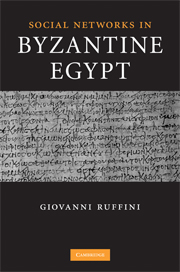Book contents
- Frontmatter
- Contents
- Dedication
- List of figures
- List of tables
- Acknowledgements
- References and abbreviations
- Introduction
- Chapter 1 The centralized elite of Oxyrhynchos
- Chapter 2 The growth of the Apions
- Chapter 3 Aphrodito and the strong ties of village society
- Chapter 4 Quantifying Aphrodito's social network
- Conclusion
- Stemmata
- Bibliography
- Subject index
- Index locorum
Chapter 4 - Quantifying Aphrodito's social network
Published online by Cambridge University Press: 26 June 2009
- Frontmatter
- Contents
- Dedication
- List of figures
- List of tables
- Acknowledgements
- References and abbreviations
- Introduction
- Chapter 1 The centralized elite of Oxyrhynchos
- Chapter 2 The growth of the Apions
- Chapter 3 Aphrodito and the strong ties of village society
- Chapter 4 Quantifying Aphrodito's social network
- Conclusion
- Stemmata
- Bibliography
- Subject index
- Index locorum
Summary
INTRODUCTION
Evidence for social life in Byzantine Aphrodito comes almost entirely from the archive or archives of Dioskoros and his family. Dioskoros and his relatives were certainly at the center of these archives. However, network analysis of this evidence indicates that he and his family were by several standards of measurement less socially important than we would have expected. These same analyses draw our attention to previously understudied members of Aphrodito's lower classes, and invite us to ask why such individuals – hidden from view because of our attention to Dioskoros and his family – might appear so structurally important for Aphrodito's social connectivity. The analyses that measure features of the network as a whole – particularly distance, centrality, and network cutpoints – indicate that Aphrodito's social network had a very low degree of hierarchy and was relatively decentralized. These results lend support to the picture of Aphrodito's social network drawn in the previous chapter. Coming from a century we picture as having rather rigid social hierarchies, this evidence opens the door to reconsidering the realities of village life throughout late antiquity.
I have already argued for the importance of strong, multiplex ties in Aphrodito village society. But the evidence supporting those results was incomplete at best, based upon a handful of well-known people. Faced with the riches of Aphrodito's papyrological corpus, modern scholars have naturally gravitated towards the most obvious characters and story-lines: Dioskoros the lawyer-poet; Phoibammon, his entrepreneurial in-law; Aphrodito's interactions with Upper Egypt's political elite.
- Type
- Chapter
- Information
- Social Networks in Byzantine Egypt , pp. 198 - 241Publisher: Cambridge University PressPrint publication year: 2008



